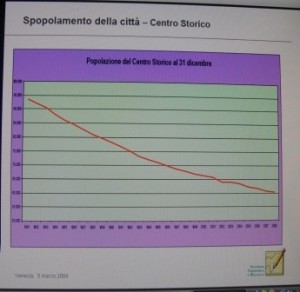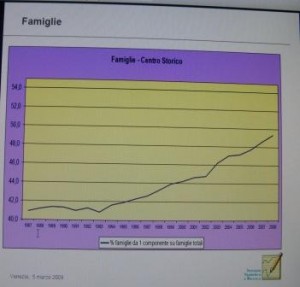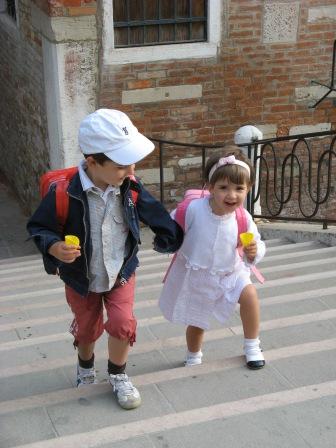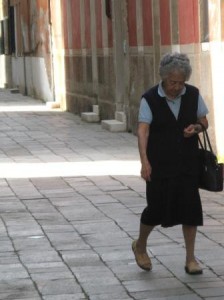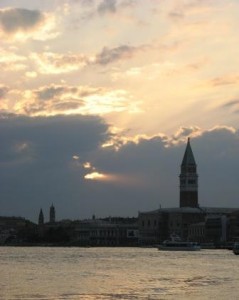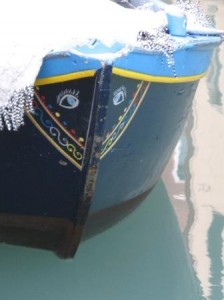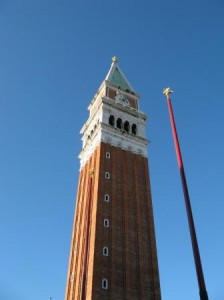“No ghe xe schei” (No ghe zeh skay). It means “There is no money,” in Venetian, and it’s a phrase one hears all too often.
If Venice were to have a soundtrack, it wouldn’t be the shimmering arpeggios of Vivaldi or Marcello, it would be this monotonous lament. The statement obviously refers to the state of the municipal coffers, but it’s an extremely versatile and handy tool. It can be used either as a weapon of attack or defense, and is also useful as an accusation. It’s as much a political as a financial remark, because it explains, excuses, and removes from discussion any problem, decision, action or inaction. “No ghe xe schei” will be the reason why something was done, or why it was not done, or how it was done, or by whom, or when. Whatever happens, it will be because there are no schei.
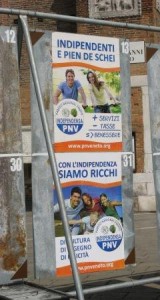
Schei is an old Venetian word from the period between 1797 and 1866, when the Austro-Hungarian Empire ruled the once-independent Venetian Republic. There was an Austrian coinage called “Scheidemunzen” (a generic term indicating that the coin was legally worth more than the metal it was made of), clearly a word that was born looking for a nickname. So the Venetians chopped off the first bit and pronounced it their own way. One scheo (SKAY-o) was one cent, that is, one one-hundredth of a Scheidemunze.
You will also still hear people use the term “franchi” to mean money. (If you were to earn some extra money, you’d tell your friends you’d “ciapa’ un franco,” grabbed some money, in the casual way we would refer to doing something on “my dime,” even if actually cost $40,000.)
The franchi don’t refer, as I once assumed, to francs circulated during the brief period when the French were the rulers here, but rather to the coinage of their successors, the Austrians. In that period there was another Austrian coin in circulation which carried the Latin name of the Emperor Franz Josef, i.e. Franciscus Iosephus. With the passion for diminutives that is one of Venetians’ more endearing traits, the money became “Franks.” So spending “franchi” would be like spending a batch of Abes or Georges today for the newspaper or a pack of gum.
While I’m off the track here, you also occasionally hear an older person refer to spending lombardi.

That goes back to the period of the Kingdom of Lombardy-Venetia (1815-1866), a sort of subset of the Austrian dominions about which I will tell you nothing more because life is short, but I will mention that Lino told me he has, somewhere in his impedimenta, at least one genuine lombardo. Very cool.
Venetians buy and sell in euros now, a word which is hopeless for fantasy, but it’s used here only in specific situations, such as paying the gas bill or pricing products. Peaches would cost four euros (not schei) a kilo, but the shopper would put them back because they cost “massa schei.” Too much money. But back to the budget.
How much money does Venice need to live on? And why does it keep coming up short? (And why do the lights blaze on all night on every floor of the Palazzo Balbi, in the offices of the Veneto Region??) The numbers, as reported in the press, don’t seem to match up, and studying the documents on the city’s website gave me the staggers, so I can only sketch some broad outlines.
As with any entity, the city has Income and Expenses. You need to increase (A) or decrease (B), or both, to keep going. Even I know that. And there has been a terrifying drop in (A) recently, the fiscal equivalent of the effect suffered by non-seat-belted passengers on a plane which suddenly hits one of those invisible air pockets. Furthermore, the world economic implosion has meant fewer tourists, and those who do come are spending much less.
Conversely, the increase in (B) has been relentless.
So while the larger world worries about water rising in Venice, the mayor is fixated on the ebb and flow of funds. That sound you hear is the city government squeezing 7 million euros out of this year’s budget. There’s plenty of pain to go around.
Income, some major sources of:
- The Casino. It pays half of its profit every year to the city; in 2007 and again in 2008 the city received 108 million euros from it. But the economic crisis has been hard on the Casino, too, and the projection for 2009 was a drop of 10 million euros from last year’s contribution. This has created a severe ripple effect on all sorts of groups who benefited from sponsorship by the Casino, which is regrettable. But for the city it has been a real body blow.
- The Port of Venice (cargo and cruises). Happily, in 2008 the Port experienced increases in both categories; Venice is now the #1 port in the Adriatic for Ro-Ro and container traffic (take that, Trieste). As for cruises, Venice is the #2 homeport in the Mediterranean and #4 in Europe. Last year Venice reached a historic maximum of 1,216,088 million cruise passengers, each of which pays a 157-euro port fee. This comes to 190,925,816 euros.
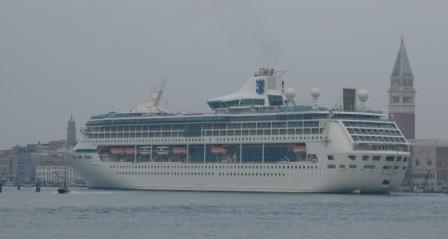
- Passenger numbers are projected to increase in 2009, despite the general economic gloom. Therefore, appalling as the sight of these pachyderms may be as they lumber past San Marco (I refer to the ships, of course, not their passengers), to the city they are bags of money floating in on the tide.
- The Special Law for Venice, the instrument by which national funds are allocated annually for a wide range of activities. This used to be a very deep pocket for Venice to reach into, but now there’s more hole than cloth. Only about 5 million euros can be expected to come from Rome, and it’s not clear if the city will even get them all, or exactly when.
- Historic buildings. In the past five years, the city has been selling whatever historic buildings it can, realizing some 400 million euros. (The sale of the former Pilsen brewery, for example, netted 40 million euros; it is destined to become yet another hotel.) The anticipated income from the next batch of buildings (if they were all to occur) is 98 million euros. But eventually there will be no more buildings left to sell, so it may be better not to count too much on this for long.
- Taxes. It’s not so much that there need to be more; there need to be more people paying the taxes which are already required. Many, many people all over Italy are known to evade paying tax on their real income. (Shocking, I admit.) Those who can manage it declare only the minimum income required by law, and the city has become involved in its own fiscal version of a land war in Asia in the effort to get the tax money it’s due on the real income made. This effort has led to many battles with, so far, not much result.
- Sponsors. This is a highly desirable source of money but, being impossible to predict or estimate, can’t be listed or quantified in any serious budgeting efforts.
Expenses:
These are all the unromantic elements of keeping a city alive, if not well, and the budget has to cover not only the historic center of Venice, but its municipal partner, Mestre, which has its own particular problems. The struggle to resolve the very different demands of the two entities — dredge a canal or build a parking lot? — is never going to let up. But whereas people come to the historic Venice and spend money (and even respond to appeals for donations for same), it’s unlikely that the same amount of money would be forthcoming from appeals to help Mestre avoid becoming a souvenir. So there is tension. Unfortunately for historic Venice, Mestre has twice as many voters.
- Sanitation
- Canal dredging
- Restoration of monuments
- Schools
- Public transport
- Hospitals
- Housing
- Anything imaginable which I have left out, including the unforeseen disaster such as the storm of September 26, 2007 which merely drenched Venice but submerged large tracts of Mestre — garages, basements, etc. The damages claimed by the residents have left a big black bruise on the budget. And there was the resolution of a festering conflict between the city and the croupiers at the Casino (the city is the Casino’s largest shareholder) concerning the declaration of their tips (taxable, naturally); the croupiers sued the city and the court found in their favor, so the city will have to pay them 11 million euros in settlement. This hadn’t been listed in the budget for 2009, one can imagine. I have no doubt that the city has a fund to absorb a certain amount of shock, but there can’t be much left anymore.
To sum up: The city budget currently shows 546 million euros in income, and the same amount in expenses. 467 million of those expenses are for operating costs: 134 million for personnel, and 79 million for the various departments. Welfare (a general term for various social costs) is 44 million. The police get all of 2 million. I won’t go on. Not much left over, as you can see, for the restoration of monuments and other more visible concerns of the most beautiful city in the world.
Mayor Massimo Cacciari could see trouble coming a year ago (even before the roof caved in on the economy of the Milky Way galaxy):
“TO SAVE VENICE REQUIRES 70 MILLION EUROS,” the Gazzettino headline read, beginning its report on the mayor’s unproductive trip to Rome, where he discovered that the Special Law had allocated Venice a mere 5 million for 2009. This is depressing, not only in itself, but because in a situation this dire, the need for money will tempt the city to give all sorts of waivers and exceptions and permissions to do things which are prohibited by various laws. The wild call of the schei, especially when it’s looking for a mate, is more unnerving than the cry of the migrating sandhill cranes at dawn.
“I explained to the Ministers that Venice needs annual refinancing of at least 60 million euros on the basis of the Special Law,” Mayor Massimo Cacciari said at the subsequent press conference. “Otherwise it will be difficult to guarantee — on the contrary, they could be blocked — projects tied to the maintenance of the city, of the dredging of the canals, to the restoration of the private buildings of the patrimony, to interventions for the socio-economic revitalization of the city, to the restructing of the government buildings.”
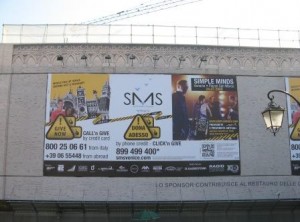
Anyone who has seen the swarms of summer tourists naturally assumes that they are all thickly padded with money, but this is not the case. On the contrary; tourism imposes more demands on maintenance (money out) than it gains from its wildly assorted visitors, most of whom — the merchants confirm — carry very little spare change these days.
Over time, the city has hazarded various proposals to increase income (and limit the number of tourists at a time, thereby controlling the maintenance problem, at least somewhat). One idea was to charge one euro from each tourist who stayed overnight (most tourism is of the “bite and run” sort, as they put it). This raised shrieks from the hoteliers, who saw it as punitive to the very people who were already actually spending money in the city. Another idea that keeps coming up is to sell an admission ticket to the city, but apart from conflict over its philosophical justification, no one has yet come up with a way to actually make it work.
So “Let’s find a sponsor” has probably surpassed “Let’s have a drink” in frequency, if not in popularity. Last year the mayor was wooing the German government for money; the movie stars who attended the Venice Film Festival were snagged as spokespeople more or less soliciting contributions; Elton John donated a bit of his music as a cell phone ringtone, the proceeds of which would go to the city.
Certainly something is better than nothing, but many of these maneuvers do have a sort of tin-cup aspect to them.
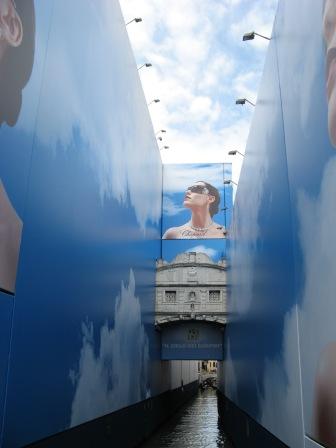
Then there are billboards, another form of sponsorship. The most overwhelming at the moment are in the Piazza San Marco area, covering the facades of the Marciana Library, part of the Doge’s Palace, the Bridge of Sighs, and the New Prisons. The aesthetic impact of these monstrous advertisements blatantly contradicts the notion that the sponsor is paying because he/she/it is sensitive to beauty and historic value. The cost of restoration has increased, and the funds have shrunk, to the point where these swathes of space are now regarded as the perfect commercial space for rent. Not a revolutionary idea in itself, but pretty subversive in a town which is also a UNESCO World Heritage Site.
There is one more aspect of the budget situation here that requires mentioning, and that is the Parris-Island-obstacle-course which an entrepreneur with a good idea has to attempt to run, from bureaucracy to high taxes to entropy, all exacerbated by the normal political parry and thrust which require time and attention too.
One such entrepreneur is yacht broker Stefano Tositti, director of BWA Yachting, and he maintains that there is much more to be earned from the luxury-yacht business than has yet been asked. “Luxury yachts is a sector that brings Venice about 10 million euros,” he told the Gazzettino; “it’s a lot of money when you consider that the work focuses on only 15 moorings used mainly in the summer. It’s not enough. There needs to be a marina adapted to the needs of people who come to Venice; here we’re not able to furnish certain services which our clients normally expect.”
In 2008, 173 of these peerless vessels adorned the embankments at the Punta della Dogana, the Riva dei Sette Martiri, and the Riva San Biagio. Some of these berths can cost 10,000 euros a day, presumably for mega-yachts such as Paul Allen’s “Octopus”
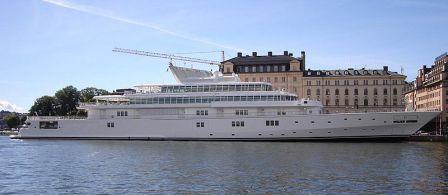
Larry Ellison’s “Rising Sun,” and Barry Diller’s “Eos,” the world’s largest sailing yacht, all of which put in to Venice from time to time. In the case of “Rising Sun,” it’s not easy to find berths it will fit into.
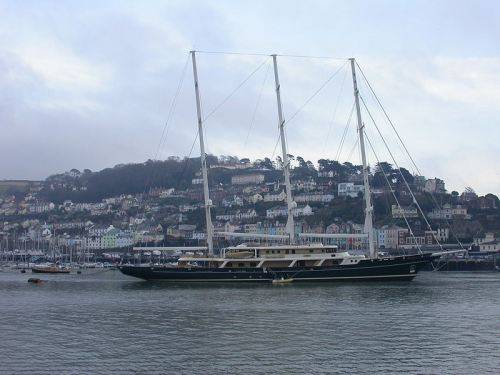
Tositti says that there are investors ready to support a marina project, and that an investment of 250 million dollars could bring earnings of 30 per cent within five years. He claims that the city could earn another 10 million euros if there were a structure for off-season storage. “The problem here is unfortunately bureaucracy,” he told the Gazzettino. “It seems as if the city doesn’t want to pay any attention to this niche market. In fact, very few berths are dedicated to this type of boat — there are very few services for yachts in general, and marinas are completely lacking in the historic center. ”
Happily, on July 2 it was reported that Moody’s had reviewed Venice’s books and awarded the city a rating of AA2, which is just below AAA and AA1. It is heartening to see that the city’s finances still pass muster. But with an eye on the drop in income from the Casino, Moody’s has also given Venice a friendly heads-up.
It appears that, at least for the near future, the margin between money made and spent in Venice will continue to be so narrow that you couldn’t even slip the average “suspension of service” notice through it. Yet still, schemes are proposed from time to time, such as the idea (since abandoned, or at least not mentioned) of installing turnstiles on all the vaporetto docks, which the city inexplicably is able to afford. This kind of maneuver only deepens the chasm between fiction and fact in this fairytale city. Yesterday the city couldn’t afford to pay more ambulance drivers, yet somehow money has materialized to install turnstiles?
It doesn’t do to dwell on these things. They only make you tired and unhappy.
###articles###


